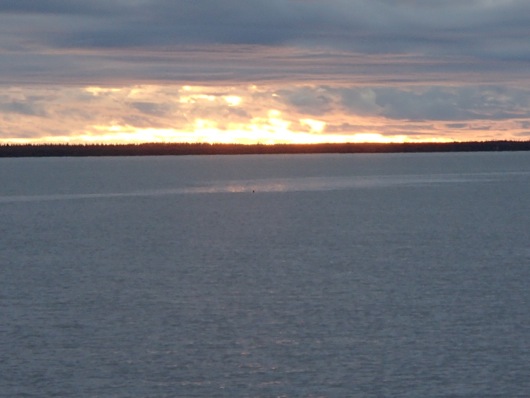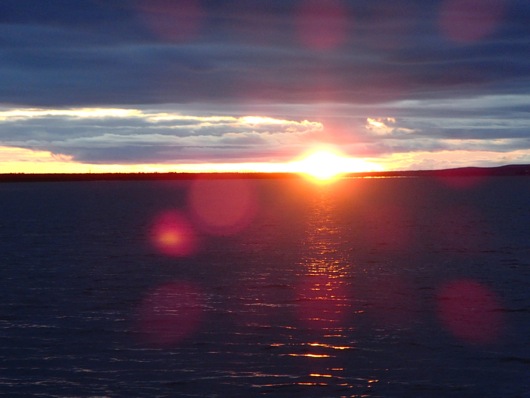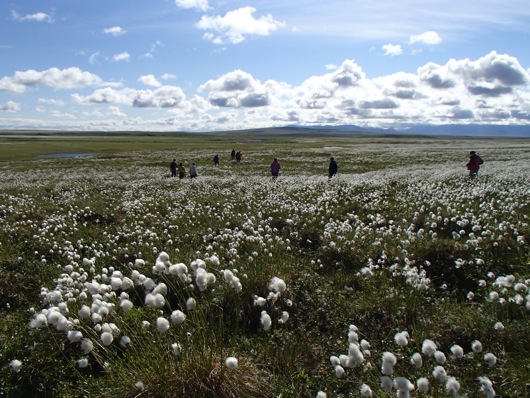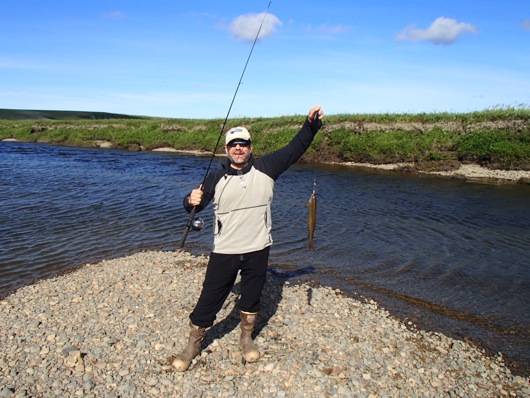(Mark Paricio is a PolarTREC Teacher accompanying the Polaris Project this summer. To read all of Mark’s journals, go to: http://www.polartrec.com/expeditions/siberian-arctic-systems-study )
North to the Windy Tundra
For our final large group adventure, we headed north at about 10 p.m. on Wednesday, June 18, our Barge being pushed by a tugboat in a similar fashion to our trip to Duvannyi Yar. This time, our goal was to visit and take samples from the tundra ecosystem and up to the mouth of the Kolyma River to the Arctic Ocean.
Two-Hour Long Sunset? Sunrise? Sundance
As our barge headed north, the sun dipped toward sunset over the northern horizon at 11:10 p.m. I am at a loss to call it a sunset, as it never really set. Rather, the sun just danced along the horizon for more than two hours, causing many of the members of the Polaris Project to fill their memory cards with the golden memories. (More than one person needed to delete some photos in the field the next day to capture more scenery!) The pictures below were the bookends of many shots I took from the barge, starting at 11:10 p.m. on Wednesday and ending at 12:57 a.m. on Thursday morning (June19).

The first color of the late night broke at 11:10 p.m. as the clouds lifted.

The most intense color of the sundance occurred at about 12:57 a.m.
Waking to No Trees (June 19, 2012)
The tugboat continued to push the barge down river throughout the night. I woke at 7:30 a.m. to the drone of the tugboat’s engines stopping as we anchored on the mighty Kolyma River. Walking out to the bow of the barge, there was not a tree in sight. We had reached the arctic tundra.
After breakfast, some of our group went in speedboats to sample nearby waterways and examine the recovery of an old burn area. The rest of us were ferried to the shore in a small boat and climbed the 10-meter tall bank of crumbling shale and quartz. When we reached the top, the last remnants of a graveyard from a long-gone settlement framed our treeless view across the tundra meadows to the mountains to our east. The enormity of the scale is impossible to gather from the pictures!

The last remnants of a graveyard from a long-gone settlement framed our treeless view across the tundra meadows to the mountains to our east. The enormity of the scale is impossible to gather from the pictures!
As we walked across the tundra, another group broke of to take a core of soil from the tundra. The rest of us walked carefully around the mounds of tussocks and through the cotton grass waving in the winds.

We walked across acres of cotton grass on our way down to the river. Dr. Seuss would have been proud of their fluffy heads swaying in the wind!
We walked to a small stream that looked perfect for fishing. Fortunately, we had an hour to spare and a few fishing poles. We were not disappointed, as we caught 15-20 arctic grayling, each between 18 inches and 24 inches. By far, the best fishermen were Seth Spawn and Eric Taber, who brought their own fly rods from home. However, even the less talented anglers (including myself) found some success!

Mark catches his second Arctic Grayling fish in the Sukharnaya tributary to the Kolyma. The first one was longer! (Sounds like a fish tale in the making…)
A Quick Change in the Weather!
After fishing, we headed back to the Barge for lunch, collecting mushrooms as we went. Our trip took about half an hour, but as is common to arctic latitudes and higher altitudes, the winds picked up dramatically. Our 200-m crossing back to the Barge was just becoming a bit sketchy when we got the last group back. We were fortunate that Nikita Zimov and Sam Berman were extremely efficient in getting groups back! Our plans to go back to the tundra after lunch were cancelled.
The groups that went out on the speedboats are (as I write at 5:00 pm.) sitting on the riverbank where they are, not risking crossing the river in the 40-50 mile-per-hour winds now blowing down river, raising whitecaps. Our plans are to wait until midnight, when the winds are predicted to subside, wait for the speedboat groups to return, and head back up the Kolyma to Cherskiy. Since it stays light this far north in summer, darkness is not a factor in our travel plans.
All Parties Back and Safe (June 20, 2012)
It is 1:00 a.m. and the two groups using speedboats have just returned! They were sitting safely until the weather broke and they could travel safely. They are hungry (how much chocolate can you eat?) but otherwise no worse for the wear.
We have just returned to the Northeast Science Station where internet seems to be available for now. This afternoon, I head back to Pleistocene Park to help with permafrost drilling again. I haven’t slept in my bed for 5 nights – but it has been totally worthwhile!
Stay curious my friends! – Mark Paricio



